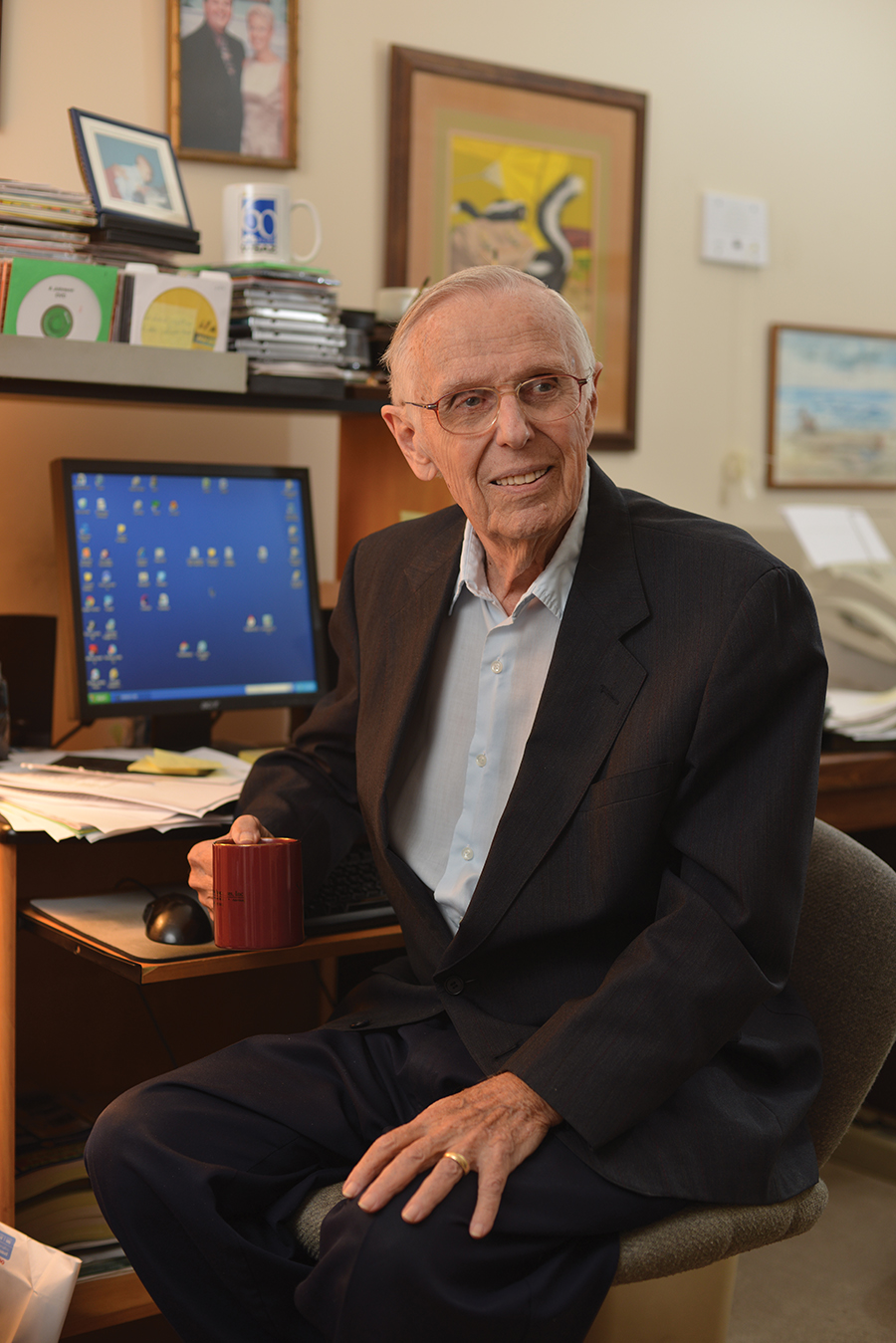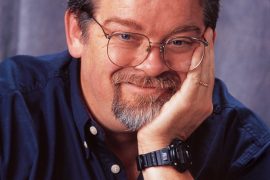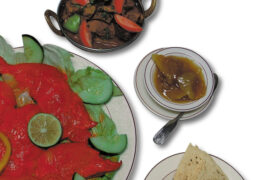For decades the Tri-State relied on the former WSAZ news director to report the region’s biggest stories
Interview by James E. Casto
HQ 84 | WINTER 2014
During the 1960s and 1970s, CBS television news anchor Walter Cronkite was often cited as “the most trusted man in America” after being so named in a national opinion poll. Had there been a similar poll in the Tri-State at that time, there’s no doubt that WSAZ news director Bos Johnson easily would have been labeled “the most trusted man in the Tri-State.”
The authoritative Cronkite covered the big stories of the day – the Vietnam War, Watergate, the slayings of President John F. Kennedy and civil rights leader Martin Luther King Jr. In much the same reassuring fashion, Johnson detailed for WSAZ’s viewers the region’s big stories.
A native of Charleston, C. Bosworth Johnson came to Huntington and WSAZ in 1952. He was named news director in 1960, succeeding the television station’s original news director Nick Basso. During that time, he helped make WSAZ the undisputed ratings leader in the Huntington-Charleston television market.
After 24 years, he left WSAZ and for the next 12 years was an associate professor of broadcast journalism at Marshall University. While teaching, he also served as a senior consultant for Charles Ryan Associates, a public relations firm. In 1988, he left Marshall to become a vice president with Ryan. Along the way, the busy Johnson somehow found time to play a leadership role in a long list of community organizations including the Campus Christian Center and Leadership Tri-State, along with teaching a Sunday School class at First Presbyterian Church.
Johnson, now 84, and his wife Dotty, a long-time Marshall professor, are now retired. HQ sat down with him in their apartment at the Woodlands retirement community for a discussion exploring his remarkable career.
I think readers would be interested to know a bit about your boyhood in Charleston.
My grandparents were in Charleston for a long time. I was born and raised the first four years in luxury. My grandfather was a state senator but died when I was 5 years old. And so the whole family had to move out of Quarrier Street, and Grammy went to a little apartment. My mother’s family were the ones that I had to really depend upon because when I was 5 my father was diagnosed with multiple sclerosis. Mother had not been trained to earn a living. She was skilled at the piano and organ, so we lived those early years on the income she could get from teaching piano and organ and playing at the First Christian Church. This was in the middle of the Great Depression. It was not an easy time, but I learned a lot out of that.
You went to West Virginia University, right?
I was a speech major at WVU. Recognizing the struggles my mother was having trying to have enough money to put me through college, I went looking for a job and was blessed with an opening at radio station WAJR in Morgantown. I was a disc jockey and staff announcer. While I was there, changes were made to the staff, and as a result they named me program director.
You were, what, about 19 then?
That’s correct. I really went down to apply to be Jack Fleming’s sidekick on broadcasts of West Virginia sports.
What did you do after you graduated in 1949?
I stayed at WAJR as program director, and as fate would have it a new faculty member came to town to teach broadcasting. We had an arrangement with WVU that they would produce radio dramas – they had a linked-up telephone line from the campus to the station. They would do the rehearsals and get it ready, and then they’d feed it down the line, where we would record it. One day, they were having a rehearsal with this new faculty member, and she told a student to go change the patch panel, and he didn’t know what he was doing, and he sent a rehearsal down the line booming out over our on-the-air radio program. And here I am responsible for straightening it out and I don’t know what to do. The next day I went on campus to find out who that witch was that was destroying my radio station. That’s how Dotty and I met. Four months later, the “witch” and I were married.
You came to WSAZ-TV and Huntington in 1952. Where was the WSAZ studio at that time?
The radio station and the new television station were jointly owned but were in different places at that time. The radio station was on 3rd Avenue and the TV station was on the 14th floor of the West Virginia Building on 4th Avenue. That was during the Nick Basso era. Nick, of course, was the station’s first news director. I came as a radio announcer, while Nick was running a TV news operation that he was building from scratch.
When did you move into the news operation?
When the TV station moved from the West Virginia Building over to a new building on Second Avenue in the late ‘50s. Nick and Ken Kurtz did TV news and I did radio. The TV station was the creation of Lawrence H. “Bud” Rogers, Jr. He knew that he couldn’t have the kind of station he wanted in Huntington. The audience just wasn’t big enough, and he had great plans. He was, after all, the son-in-law of the family that owned the Huntington newspapers and WSAZ. Bud came up with the idea of a two-station market that included both Huntington and Charleston. Nick was the one who did the news part of it, but he and Bud together decided they had to have stringers – people who would go out and get stories in these outlying communities. Meanwhile, I was watching and learning. Eventually, both Bud and Nick were hired by Taft Broadcasting which left me with the responsibility of taking over the newsroom.
Talk about the WSAZ two-city newscasts that proved to be a predecessor of NBC’s highly successful Huntley-Brinkley report, with Chet Huntley airing from New York and David Brinkley from Washington.
The engineers were the real geniuses behind it. It wasn’t the programming people. The engineers learned how to do it, setting up a system that had never been set up before. In the beginning, they had all kinds of problems. But they got the thing going, and then we learned from there. I went over to Charleston to do the newscast because I was a Charleston native.
When it comes to the big stories you covered over the years, to a great extent it’s a list of tragedies, and that list starts with the 1963 assassination of President Kennedy.
A bunch of us from the station and the newspaper were having lunch at Jim’s Restaurant, as we often did. We were at one of those big tables up in front by the outside windows. I can still remember every detail of the day. A phone rang and one of the waitresses answered it. Then she came over and said, “There’s a call for you, Bos.” I went over and answered the phone. It was a young girl we’d hired only recently as the newsroom secretary, and she said, “I’m so sorry to bother you at lunch. I didn’t want to, but Mr. Bowen (the station’s sports director) said I had to call you right away.” “Well, what is it?” I asked. She told me there was a story on the wire that President Kennedy had been shot. I rushed back to the table and told the others. Everybody just looked at me, then got up and hurried out.
Just before Christmas in 1967, the Silver Bridge that crossed the Ohio River connecting Point Pleasant and Gallipolis collapsed. WSAZ was called upon to communicate an unspeakable tragedy to its viewers. What do you remember about the Silver Bridge collapse?
Dotty had come by to pick me up to go to the WSAZ Christmas party and she was immediately drafted into manning the telephone. Shortly thereafter, a man who had survived the bridge collapse called in and told Dotty what had happened. She tried desperately to get my attention during the call so I could interview the man, but I was so engrossed in a conversation that I never saw her. I still regret that to this day. But then I made an even bigger mistake. While I knew it was the Silver Bridge that had collapsed, I couldn’t remember if that was the bridge that went across the Kanawha River or the one that went across the Ohio. I sent a photographer quickly on the way but then realized “What if I’m sending the photographer on the wrong side of the river?” So I had to send a second photographer to the other side.
Delivering the news about 1970’s Marshall plane crash surely must have been the most challenging moment of your long career.
The first phone call came from a woman who said, “You must never tell anybody who I am.” She was the wife of one of the employees, probably an airport employee. And she said, “You’ve got to protect me,” and I said, “Sure, what’s wrong?” She said there had been a plane crash. Well, I just had gotten a phone call from a reporter on our weekend staff telling me there was a crash but he didn’t know anything about it. The woman said, “It’s the Marshall plane.”
You went to the crash scene, didn’t you?
Yes, Roger O’Neill (who later would join NBC) and I went out to the scene, getting closer than we were going to be allowed later on after they put up the barriers. We interviewed people who lived right around there who had seen the crash. But the thing that sticks in my head is this: I kicked a piece of luggage, looked at it and recognized it. It was the luggage that contained the cameras of the Marshall sports photographer. I had just sat with him at the Field House a few nights before and had accidentally kicked that same suitcase.
What do you think enabled you to go on camera and deliver that story?
I don’t know to this day, because if you think about it, you just choke up immediately. Recently, my dentist told me that he and his girlfriend were watching the news when I went on air and reported that the Marshall plane had crashed and all 75 passengers, including her parents, were dead. If I had been thinking about something like that on the air, I couldn’t have done it. So it’s obvious that I just drew some kind of a curtain over me and told myself: I’ve got to read these words and get them out.
You said you’ve never been to any of the annual memorial services at the fountain on the Marshall campus. Why is that?
Now, wait a minute. That’s technically not correct, because when the We Are Marshall movie was made and they had the huge closing scene with all the people around the fountain, Dotty and I were there. So I guess that breaks the string. But I don’t go to the memorial services because I don’t need to be reminded. It’s in my head – period.
The string of disasters continued in 1972. A coal waste dam on Buffalo Creek in Logan County collapsed, sending a 30-foot wave of water crashing down the valley, sweeping away everything in its path.
Buffalo Creek is far enough away from both the Huntington and Charleston newsrooms that we had a hard time getting reporters in there. It was just the genius of the original setup by Bud Rogers and Nick Basso of a stringer system that did it for us. A young woman from Logan County, carrying her silent camera, plunged into that horrible situation and got us dramatic, wonderful film. Can you imagine what she went through just trying to get to the scene to get the story?
You were active for a number of years in the Radio and Television News Directors Association (RTNDA) and eventually became that national group’s president. In that capacity in 1974, you had occasion to put a question to President Nixon at a news conference not long before he resigned.
Nixon was having news conferences around the country rather than in Washington because he wanted to avoid the Washington press corps. In Dallas, he appeared at a meeting of the National Association of Broadcasters and as RTNDA president, I was to ask the first question. The question was easy to come by. We had a meeting beforehand to come up with it and Paul Davis, news director at WGN Chicago, suggested the question for me. In asking it, I noted that a conservative senator had called on him, as “an act of supreme statesmanship,” to resign. “How will you respond?” I asked. “Will you resign?” He said no, of course, and then a few weeks later, he did in fact resign.
When you left WSAZ in 1976, you went to Marshall to teach. What did you like best about your new role as Professor Johnson? Did you miss the newsroom?
No. Isn’t that surprising? I had been there long enough. This was a brand new challenge, and it enabled me to work in the same building as my wife Dotty who was in the speech department. But looking back on it, I realized I had come out of broadcasting, not journalism. So I learned as I went, and I spent a lot of time on the phone with Marshall journalism people helping me. I went from being a teacher in the newsroom to a teacher in the classroom, and I truly enjoyed it. Teaching at Marshall was one of the most fulfilling chapters in my life.
When I think of Bos Johnson, one of the words that occurs to me is mentor, because you have mentored a couple of generations of journalists, first in the WSAZ newsroom and later at Marshall. A number of those folks have gone on to do some pretty impressive professional work.
I am so proud of what Roger O’Neill went on to do at NBC, and I wonder how many folks are going to remember Huntington native Bill Stewart, who moved on to ABC News and was senselessly murdered while he was covering the fighting in Nicaragua. He was our 11:00 anchor, and a very good, successful one. Bill was a wonderful guy. They asked me to come to New York when they did the memorial service for him. Sean Callebs was with CNN for ages. He’s now with a Chinese network doing U.S. news for the Chinese. Joe Johns, who really was more Dotty’s student than mine, is now doing significant work for CNN. There’s been a whole stream of them. I grin when I recognize what they’re doing. Tom Jacobs has been running his own company up in Cleveland doing videos and now is at a brand new network. Ken Kurtz and Jerry Sander are down in Lexington, Ky. Cathy Midkiff Lewis is now in the Norfolk/Newport News area where she’s executive director of the Civic Leadership Institute. She also hosts and produces her own statewide Virginia radio program and is on National Public Radio regularly. There are so many. I know I’m leaving out ones that are going to embarrass me later, but it’s just one after another after another.
How do you think today’s Huntington is different than the community you came to in the 1950s, and what do you see ahead for Huntington?
It’s interesting, because Huntington changes. It was one city when we moved here, 80,000 people and a great deal of manufacturing. Well, the manufacturing has shrunk, but I see all kinds of other civic involvement of new groups staffed by people I haven’t met. It’s a generational thing, and I’m out of the new generation, but they’re doing some wonderful things in this town. Recently I was in the hospital for five days. Today’s Cabell Huntington Hospital is nothing like the Cabell Huntington of 20 years ago. St. Mary’s is nothing like it used to be, and incidentally, the PR directors of both hospitals are former broadcast journalists. Yes, we’ve lost much of our manufacturing base, but thanks to the Marshall medical school and the community’s hospitals we have become a major medical center.
Your son, Rob, has followed in your footsteps in the newsroom at WSAZ, and that obviously must be a source of family pride for both you and Dotty. Besides watching Rob and the other folks on Channel 3, what other news do you watch?
We do watch Rob and are very proud of him. But I’m not happy with news today and what’s on the air. I don’t like the approach taken by both the local and national news networks. But you have to remember how old I am. I don’t think today’s generation would accept what we ran for news. Instead, they want the accidents and the sensational stuff, and I just don’t think we cover the important event-type things locally. I don’t think that our local stations pay attention to the deeper issues. But on the other hand, I think they probably have done enough research to demonstrate to me that they’re doing what the audience wants.





